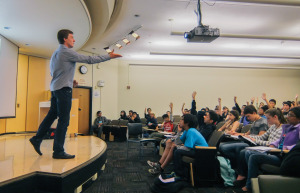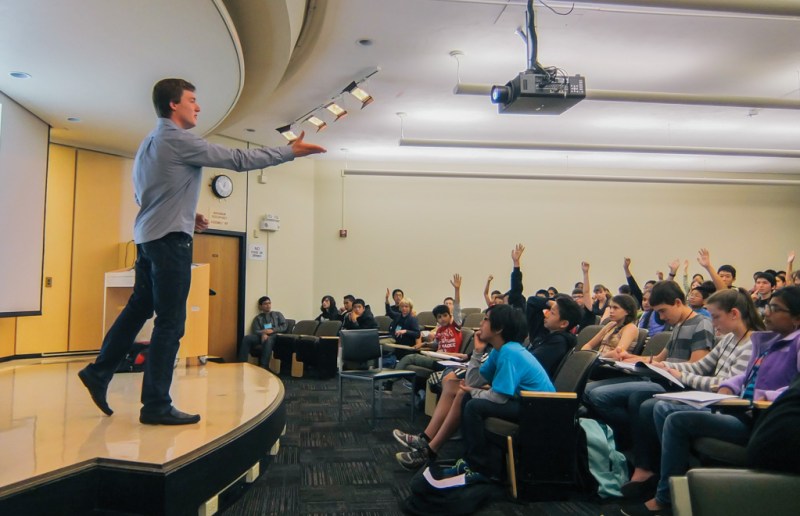
While Stanford students are normally doing the learning, this weekend saw the roles reversed as Stanford Splash hosted 2000 middle school and high school students.
Stanford Splash is a large-scale attempt to help Stanford students, middle schoolers and high schoolers engage on a higher educational level. Stanford students and other community members design and teach classes to local middle and high school students.
“It is education for students by students,” said Alfred Zong ’15, a member of Splash’s administrative team.
The goal of the event is twofold, according to Zong: to expand the educational horizons of high schoolers and to give them a chance to experience college-level classes with a wider selection of classes that are nontraditional.
Classes for the program vary from physics and linguistics to dance, cooking and the ever-popular “Quidditch for Muggles.” The idea is for Stanford students to exercise leadership and understanding in education, said Hilary Noad, a member of the Splash administrative team and a fourth-year Ph.D. student in astrophysics.
“It’s a meta-learning environment in which the Stanford students who are teaching are helping other people learn, but are also learning about teaching,” Noad said.
This emphasis on the nontraditional aspects of education are part of the fun, say participants and instructors.
“I joined Splash because I enjoy teaching, and I think my topic is fascinating,” said Andrew Granato ’17, who taught a class on Karl Marx and capitalism. “My course description emphasized that Marxist theory is highly abstract and difficult, and the students who signed up … were very knowledgeable history buffs.”
Over the course of a year, the Splash administrative team works on logistics, including finding space for the event, which usually takes up most of the available rooms in the Main Quad area. Securing dance space and cooking space is the most difficult, says the Splash team. And an issue they consistently run into is not a lack of space or interested students, but not enough Stanford student-teachers.
To combat this problem, Splash hopes to expand its program in the coming year to include a smaller event called Splash-and-Dash. “[It will] give potential teachers an idea of what they’re getting into,” Zong said.
Below are a sample of the wide variety of classes taught at Stanford Splash.
Into the Fourth Dimension
Have you ever wondered what a four-dimensional cube looks like?
Overview:
Over 100 students crammed into the basement of the psychology building to learn how to visualize the fourth dimension. Led by Grant Sanderson ’15, the class examined three-dimensional projections of the four-dimensional equivalents of the sphere, cube and torus using a program Sanderson developed himself.
Students Speak:
“It makes more sense now, still confusing. But I guess it’s meant to be confusing.” — Ben, an eighth grader from San Jose
Takeaway:
It is very difficult to try and visualize the fourth dimension right away. Start by thinking about how a two-dimensional character might interpret a cube. They wouldn’t see the cube itself — they would see its projection onto the second-dimensional plane. Now try to extrapolate this process to the fourth-dimension.
Architecture 4 Humanity
Take a good look at the room around you. How high is the ceiling? Where are the windows located? Why were they placed there?
Overview:
To local architect Kenneth Huo, the key to better understanding architecture is careful observation. In the class, he led students to ponder the rationale behind architectural choices. Students examined stairs, arches and even Hoover Tower to figure out why and how they were designed.
The class also formed columns, tension bridges, domes and more with their own bodies in order to gain an intuitive sense of what physical forces are at work in the construction of such structures.
Students Speak:
“I’ve been interested in architecture for a while now, and I just wanted to know more about it.” — Addison, an eighth grader.
Takeaway:
Walk around campus with an open eye. From Memorial Church to the small hills in the Engineering Quad, most structures have had an incredible amount of thought put into their construction. Try to figure out how and why these structures look the way they do.
How to Travel for (almost) Free
Eager to travel but hesitant of the cost?
Overview:
Yongjian Si ’15 talked to students about how he traveled through Mexico, China, Japan and Spain while avoiding the tourist traps and expenses frequently associated with trips to other countries.
Takeaway:
With a good amount common sense and precaution, sites that help you stay with and meet locals, such as couchsurfer.org or airbnb.com, can add a valuable perspective to your traveling experience. If you want to find your own lodgings, you can still learn a lot about life abroad by meeting up with a local for a meal.
Contact Nathaniel Okun at nokun ‘at’ stanford.edu.
